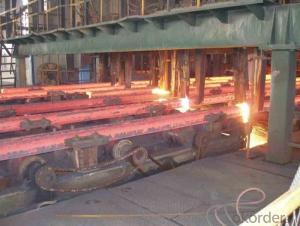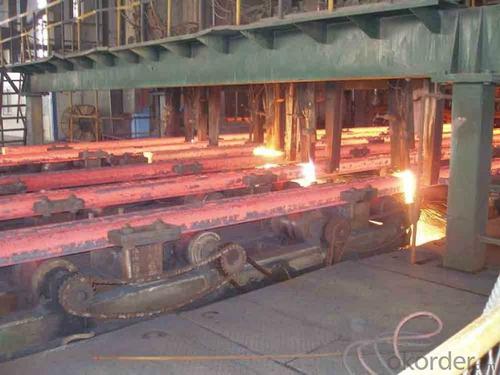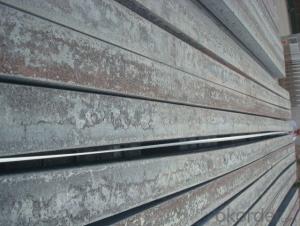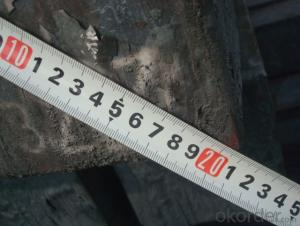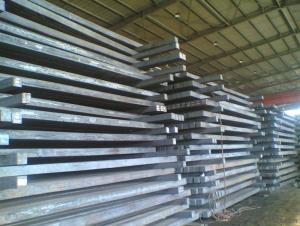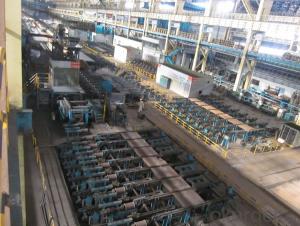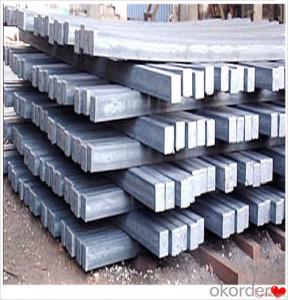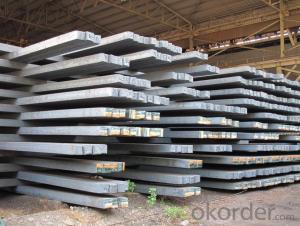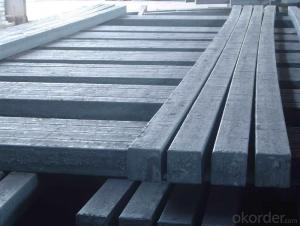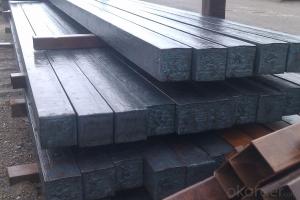Prime square alloy steel billet 175mm Q235
- Loading Port:
- Shanghai
- Payment Terms:
- TT OR LC
- Min Order Qty:
- 100 m.t.
- Supply Capability:
- 10000 m.t./month
OKorder Service Pledge
OKorder Financial Service
You Might Also Like
Structure of Prime square alloy steel billet 175mm Q235

Description of Prime square alloy steel billet 175mm Q235
1) Excellent corrosion resistance: The zinc layer provides a good protection of Pre-painted Galvanizeed Steel Sheet.
2) High heat resistance: The reflective surface of the material aids in efficiently reflecting the sunlight away and in turn reducing the amount of heat transmitted. The thermal reflectivity converts into energy savings.
3) Aesthetics: Pre-Painted Galvanized steel sheet is available in plethora of patterns and multiple sizes as per the requirements that given by our customers.
4) Versatility: can be used in the various areas.

Main Feature of Prime square alloy steel billet 175mm Q235
Uncoated CR steel sheet
With the features of in line with the international highest standards in demension and shape, excellent surface finish and properties, the products are mainly used in home appliance and automobile industries.
Galvanized steel sheet(include HDG and EG)
With the features of good corrosion resistance, the products are mainly used in automobile, home appliance, electronics, building and machinery manufacture industries, etc.
Precoated steel sheet
With the features of enviromental protection and good processablility, long lasting surface durability, rich in colors, the products are maily used in building, home appliance and furniture industries, etc.
Applications of Prime square alloy steel billet 175mm Q235
1) Excellent corrosion resistance: The zinc layer provides a good protection of Pre-painted Galvanizeed Steel Sheet.
2) High heat resistance: The reflective surface of the material aids in efficiently reflecting the sunlight away and in turn reducing the amount of heat transmitted. The thermal reflectivity converts into energy savings.
3) Aesthetics: Pre-Painted Galvanized steel sheet is available in plethora of patterns and multiple sizes as per the requirements that given by our customers.
4) Versatility: can be used in the various areas.

Specifications of Prime square alloy steel billet 175mm Q235
Product | Billet |
Material Grade | SGCC / SGCH / DX51D+AZ, etc |
Thickness | 0.6-3.0mm |
Width | 500-1500mm |
Tolerance | Thickness: +/-0.02mm , Width:+/-2mm |
Zinc-coating | Z30-150g/m2 |
Technique | Raw material: Hot rolled steel coil --> Cold rolled_>hot dipped galvalume |
Surface | Dried, Chromated, Unoiled |
Spangle | Regular spangle , small spangle, zero spangle |
ID | 508MM 610MM |
Coil weight | 1-25MT |
Export package | Cardboard inner sleeves, Waterproof paper, galvanized steel covered and steel strip packed |
FAQ of Prime square alloy steel billet 175mm Q235
We have organized several common questions for our clients,may help you sincerely:
1. How Can I Visit There?
Our company is located in Tianjin City, China, near Beijing. You can fly to Tianjin Airport Directly. All our clients, from home or aboard, are warmly welcome to visit us!
2. How Can I Get Some Sample?
We are honored to offer you sample.
3. Why choose CNBM?
we always fix steel produce in container well to make it safe arrive at destination port
we always provide best and professional forward service for our buyer
we always apply 14days free detention for our buyers container in destination
we provide one set After-sales service for our buyer
we provide China inland steel market price report
we help our buyer become number one in local market .
- Q: Are steel billets used in the production of electrical appliances?
- Yes, steel billets are commonly used in the production of electrical appliances. Steel is a versatile material that offers several advantages such as strength, durability, and resistance to corrosion. It is widely used in the manufacturing of various components of electrical appliances, including the outer casing, frames, and internal structural supports. Steel billets are an intermediate product in the steel manufacturing process and can be further processed into different shapes and sizes to meet the specific requirements of electrical appliance production.
- Q: What do you mean by adding carbon to a table tennis racket?
- The addition of carbon fibers increases the elasticity of the racket so as to increase the strength of the strike ball
- Q: What are the different surface treatments for corrosion resistance in steel billets?
- There are several surface treatments available for enhancing corrosion resistance in steel billets. These treatments are crucial in preventing the formation of rust and oxidation, which can significantly deteriorate the quality and lifespan of the steel billets. Some of the commonly used surface treatments for corrosion resistance in steel billets include: 1. Hot-dip galvanizing: This process involves immersing the steel billets in a bath of molten zinc, forming a protective coating on the surface. The zinc coating acts as a sacrificial layer, shielding the steel from corrosion. 2. Electroplating: This method involves depositing a thin layer of a corrosion-resistant metal, such as nickel or chromium, onto the steel billet's surface using an electrochemical process. The plated metal acts as a barrier, preventing direct contact between the steel and corrosive agents. 3. Passivation: This treatment involves treating the steel surface with chemicals, typically an acid solution, to remove any impurities or contaminants that may promote corrosion. Passivation creates a passive oxide layer on the surface, which provides corrosion resistance. 4. Powder coating: In this process, a dry powder is applied to the steel billet's surface electrostatically and then cured under heat. The powder melts and forms a protective layer on the steel, which offers excellent corrosion resistance. 5. Organic coatings: These coatings, such as paints or varnishes, are applied to the steel billet's surface. They provide a protective barrier against moisture and corrosive agents. Organic coatings can be customized to meet specific requirements in terms of color, texture, and durability. 6. Anodizing: This treatment is typically used for aluminum or aluminum alloy steel billets. It involves creating an oxide layer on the surface by subjecting it to an electrochemical process. The resulting anodized layer enhances corrosion resistance and also provides an aesthetic appearance. It is important to choose the appropriate surface treatment based on the specific requirements of the steel billets, considering factors such as the intended application, environmental conditions, and expected lifespan. Regular maintenance and periodic reapplication of the surface treatment may also be necessary to ensure continued corrosion resistance.
- Q: What is the role of steel billets in the production of railway wagons?
- The role of steel billets in the production of railway wagons is crucial as they serve as the primary raw material for manufacturing various components of the wagons. Steel billets are essentially semi-finished steel products that are cast into a specific shape, typically a square or a rectangle, and are used as the starting point for further processing. In the production of railway wagons, steel billets are first heated to a high temperature and then passed through a series of rolling mills to shape them into desired forms such as beams, plates, angles, channels, or other structural components. These components form the structural framework of the wagons, providing strength, durability, and stability. Steel billets are preferred in this process due to their exceptional strength and ability to withstand heavy loads, making them ideal for railway applications. They possess excellent mechanical properties, including high tensile strength, which ensures the wagons can endure the stresses and strains experienced during operation. Moreover, the use of steel billets allows for flexibility in design and customization, as they can be easily shaped and formed according to specific requirements. This adaptability enables manufacturers to produce railway wagons of various sizes, configurations, and capacities, catering to different transportation needs. Furthermore, steel billets are highly resistant to corrosion, which is particularly important for railway wagons exposed to harsh environmental conditions, such as rain, snow, and humidity. This resistance helps to maintain the structural integrity of the wagons, preventing premature deterioration and ensuring their long service life. Overall, the role of steel billets in the production of railway wagons is indispensable. They provide the necessary strength, durability, and customization options required for manufacturing robust and reliable wagons that can withstand the demanding conditions of railway transportation.
- Q: How do steel billets contribute to the aerospace industry?
- The aerospace industry heavily relies on steel billets as they serve as the essential raw material for producing various components and structures used in aircraft. These semi-finished metal forms, created through continuous casting, play a crucial role in the manufacturing process. Once formed, the steel billets undergo further processing using techniques like forging, machining, and heat treatment to transform them into different aerospace components. This allows for the customization of billets into specific forms like engine parts, landing gear components, structural frames, and other critical elements. Utilizing steel billets in the aerospace industry offers numerous advantages. Firstly, steel is renowned for its strength, durability, and exceptional mechanical properties, making it an ideal material for applications that prioritize safety and reliability, such as in the aerospace sector. Steel billets can withstand extreme conditions like high temperatures, pressure, and stress, making them suitable for critical parts that need to perform under demanding circumstances. Moreover, steel billets provide cost-effectiveness and versatility in manufacturing. Steel is readily available and comparatively more affordable than other metals used in aerospace applications. Additionally, the ability to shape and process steel billets into various forms and sizes allows for flexibility in designing and producing aerospace components, ensuring they meet specific requirements and standards set by aircraft manufacturers. Another significant contribution of steel billets to the aerospace industry is their compatibility with advanced manufacturing technologies. Steel can be easily machined, welded, and joined, facilitating the integration of complex features and structures in aerospace components. This compatibility with modern manufacturing techniques allows for the production of lightweight yet robust parts, enhancing overall fuel efficiency and aircraft performance. In conclusion, steel billets are indispensable in the aerospace industry as they provide the crucial raw material for manufacturing critical components and structures used in aircraft. Their high strength, durability, cost-effectiveness, and compatibility with advanced manufacturing technologies make steel billets an essential element in constructing safe, reliable, and efficient aerospace systems.
- Q: How do steel billets contribute to the manufacturing of electrical appliances?
- The manufacturing of electrical appliances heavily relies on steel billets, as they offer a strong and long-lasting material for different components. Robust structures are crucial for electrical appliances like refrigerators, washing machines, and air conditioners, as they need to withstand continuous usage and external forces. To create these sturdy structures, semi-finished metal products called steel billets are employed as raw materials in the manufacturing process. To begin with, steel billets are shaped and sized through forging or rolling to produce the frames, chassis, and housing of electrical appliances. These components provide vital support and protection for the internal parts of the appliances. Due to its strength and stability, steel is an ideal choice to endure the weight and vibrations generated during the operation of electrical appliances. Moreover, steel billets are utilized for fabricating the motor cores and transformer cores in electrical appliances. Motor cores play a crucial role in converting electrical energy into mechanical energy, whereas transformer cores regulate voltage in electrical circuits. Steel's magnetic properties, such as high electrical conductivity and low hysteresis loss, make it an excellent option for these applications, ensuring efficient energy conversion and transmission. Furthermore, steel billets are employed in the manufacturing of heating elements and electrical contacts in appliances like stoves, ovens, and switches. These components demand materials that can withstand high temperatures, resist corrosion, and exhibit excellent electrical conductivity. Steel billets are often alloyed with other metals like nickel or chromium to enhance these properties, making them highly suitable for such applications. In conclusion, steel billets make a significant contribution to the manufacturing of electrical appliances by providing a durable and versatile material for various components. The strength, stability, and magnetic properties of steel make it an essential raw material for creating the frames, motor cores, transformer cores, heating elements, and electrical contacts used in these appliances. Thanks to steel billets, electrical appliances can perform reliably and efficiently, meeting the needs and expectations of consumers.
- Q: How are steel billets used in the manufacturing of oil and gas equipment?
- The production of oil and gas equipment heavily relies on steel billets. These semi-finished steel products act as the foundation for creating various equipment used in the oil and gas industry. Steel billets are primarily used in pipe manufacturing. To withstand high pressure, extreme temperatures, and corrosive environments, oil and gas pipes require raw materials that can meet these demanding requirements. Steel billets are heated, pierced, and elongated through extrusion to form seamless pipes. Alternatively, they can be rolled and welded to create longitudinally welded pipes. Additionally, steel billets are essential in the production of valves, fittings, and flanges. Valves are critical in controlling the flow of oil and gas, while fittings connect pipes and change their direction. Flanges provide a means of connecting pipes, valves, and other equipment through bolting. All of these components require steel billets as a starting material, which are then machined, shaped, and heat-treated to meet necessary specifications. Furthermore, steel billets are utilized in the fabrication of drilling equipment and offshore structures. Drilling equipment, including drill bits, drill collars, and drill pipes, are vital for oil and gas exploration and extraction. High-quality steel billets are crucial to ensure the strength and durability of these components, which endure intense forces and harsh conditions. Offshore structures, such as platforms and rigs, also rely on steel billets to construct frameworks and support systems that withstand the challenging marine environment. In conclusion, steel billets are irreplaceable in the manufacturing of oil and gas equipment. They serve as the raw material for pipes, valves, fittings, flanges, drilling equipment, and offshore structures. By starting with high-quality steel billets, manufacturers can produce durable and reliable equipment capable of withstanding the demanding conditions of the oil and gas industry.
- Q: How does the market demand for steel billets fluctuate over time?
- The market demand for steel billets fluctuates over time due to various factors such as economic conditions, industrial growth, infrastructure projects, and global trade dynamics. During periods of economic growth and expansion, there is typically an increased demand for steel billets as it is a crucial raw material for construction, manufacturing, and transportation sectors. Conversely, during economic downturns or recessions, the demand may decrease as construction projects are delayed, manufacturing activities reduce, and consumer spending declines. Additionally, market demand for steel billets can be influenced by changes in government policies, trade tariffs, and technological advancements in alternative materials. Overall, the market demand for steel billets is subject to cyclical fluctuations driven by economic conditions and industrial activities.
- Q: What are the advantages of using steel billets in manufacturing?
- There are several advantages of using steel billets in manufacturing. Firstly, steel billets are highly versatile and can be easily shaped into various forms, making them suitable for a wide range of applications. Secondly, steel billets have excellent strength and durability, ensuring the final products made from them are strong and long-lasting. Additionally, steel billets have good resistance to corrosion and can withstand high temperatures, making them ideal for use in harsh environments. Lastly, steel billets are readily available and cost-effective, making them a preferred choice for many manufacturers.
- Q: What are the potential safety risks associated with handling steel billets?
- Handling steel billets can pose several potential safety risks. First and foremost, the weight of steel billets can be substantial, and improper lifting or carrying techniques can lead to musculoskeletal injuries such as strains and sprains. It is important to use proper lifting equipment and techniques to minimize the risk of these injuries. Another potential safety risk is the sharp edges and corners of steel billets. If not handled carefully, these edges can cause lacerations or puncture wounds. Wearing appropriate personal protective equipment, such as cut-resistant gloves, can help mitigate this risk. Steel billets may also be hot when they are being handled, especially if they have recently been processed or manufactured. Contact with hot billets can result in burns or thermal injuries. It is crucial to use heat-resistant gloves or other protective measures when handling hot steel billets. Additionally, steel billets are often transported using heavy machinery such as cranes or forklifts. Operating these machines without proper training or supervision can lead to accidents, including collisions, falling objects, or overturning of equipment. Adequate training, following safety protocols, and maintaining clear communication are essential to minimize these risks. Finally, steel billets may contain various chemical coatings or residues, which can be hazardous if ingested, inhaled, or come into contact with the skin. It is important to be aware of any potential hazardous substances present on the billets and take appropriate precautions, such as wearing protective clothing, gloves, and respiratory equipment if necessary. Overall, the potential safety risks associated with handling steel billets include musculoskeletal injuries, lacerations or puncture wounds, burns or thermal injuries, accidents involving heavy machinery, and exposure to hazardous substances. Following proper safety procedures, using appropriate protective equipment, and receiving comprehensive training can help mitigate these risks and ensure a safe working environment.
Send your message to us
Prime square alloy steel billet 175mm Q235
- Loading Port:
- Shanghai
- Payment Terms:
- TT OR LC
- Min Order Qty:
- 100 m.t.
- Supply Capability:
- 10000 m.t./month
OKorder Service Pledge
OKorder Financial Service
Similar products
Hot products
Hot Searches
Related keywords





